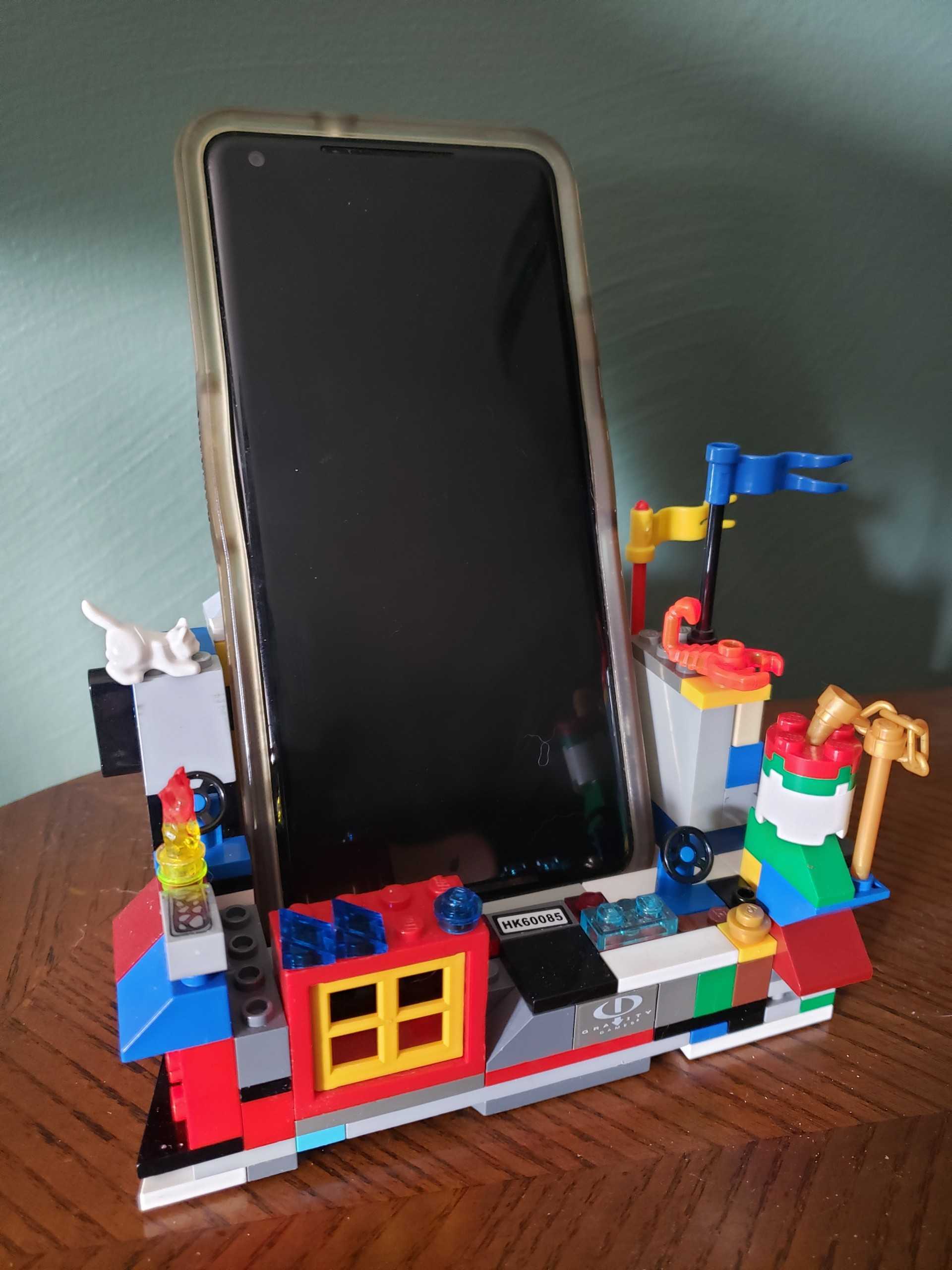
Regular readers of Tartan Datascapes will know that I like to draw comparisons between things in popular culture and data management. And for this month’s release of the blog, I wanted to focus on an irresistible comparison between using Legos to build cell phone stands for a desk and “good enough” data management practices! So get cozy (and maybe grab a stack of Legos to play with), and let’s dive in!
Recently, I was chatting with a friend over Zoom and he showed me a really neat cell phone stand he built out of Legos, so he could keep his phone upright on his desk while he was working during the day. Cell phone stands are super convenient for keeping track of your phone during the day, and also keeping your phone upright for when you are watching videos, listening to music, etc. The downside is that these stands can be a bit pricey, so my friend decided he’d save the money and just built a stand from Legos he had on hand! I was inspired by his idea, so I decided to do the same with the small stockpile of various Legos I had collected over the last several years. While I was hoping to build something simple and sleek like some cell phone stands I had seen in the past, I quickly realized that I just didn’t have the right style of Legos on hand to build the design I wanted. Instead, I kept building a design based on what Legos I had in my stockpile, and about 30 minutes later, I ended up with what I believe is a really cool DIY cell phone stand!

Is it as sleek and sturdy as the cell phone stands I could buy from tech websites/stores? No, not really. Is it good enough for my needs? Absolutely. And it’s certainly more unique than most of the cell phone stands I could find online!
Having a “good enough” cell phone stand made me think about my affinity for “good enough” data management practices. In data management education, it’s common to hear the phrase “best practices,” which describe the most ideal data management practices you could use in your research to keep your data organized and tidy. These practices generally pertain to how you name your data files, storage and backup procedures, writing documentation of your data, assigning metadata, etc. I actually don’t like this phrase and I don’t use it in my data management workshops at CMU, because for a researcher to actually implement each and every “best practice,” they would need infinitely more time, a larger research team, more funds for resources, and maybe even a healthy dose of magic. Researchers may have time barriers, financial barriers, or a host of other barriers that keep them from implementing each of these practices. If a researcher can’t implement the “best practices,” does it mean they are bad researchers, or bad data managers? Not at all! Instead, I like to use the phrases “good practices,” “recommended practices,” or “good enough data management.” It recognizes that not everyone has the time, money, or resources to make sure their data management is impeccable. Sometimes, “good enough” data management is enough to support organized and tidy data in a research project! In my conversations with researchers across the CMU campus, many individuals have told me that they know these “best practices” exist, but it’s simply not possible for them to always implement them in a project due to the time burden they can impose. Instead, they turn to “good enough” data management practices, and this supports their research agenda while keeping their data reasonably organized and tidy.
If I had a better selection of Legos, I probably could have built a much more sleek and sturdy phone stand, but I used the Legos I had on hand and built something just as good, with a unique personal touch! Many researchers see the benefit of managing their data, and if they had more time and resources, they’d likely try to implement the highest standards of data management in their research. But, they understand the reality of what they are able to do with the time and resources they have, and oftentimes, “good enough” data management practices are enough.
So, what do “good enough” data management practices look like? It depends on the research/researcher, but here’s a good example: we often speak about the 3-2-1 technique in data security, which refers to making sure you have three copies/backups of your data, in at least two different storage formats, with one of those copies living off-site or in the cloud. For most data, this is a solid technique for reducing your chances of data loss and is definitely considered a “best practice” in data management. But, it can cost money to create backups of your data following the 3-2-1 technique! Although CMU provides access to Google Drive which can serve as a good backup storage location, what if you are working with restricted data that can’t be stored there? What if you want to put a copy of your data on an external hard drive, but your research team doesn’t have the funds to purchase this equipment? Researchers don’t always have the same access to these resources to support the “best practices” in data management. In cases where a researcher is finding it difficult to satisfy the 3-2-1 technique, even keeping one copy of the data is better than nothing. Is it ideal? Not really, but it’s better than having no copies. Maybe the researcher can only keep all three copies of their data in the same storage format. Again, is this ideal? Not really, but it might be the “good enough” option given what the researcher has time and access to. And, it’s infinitely better than just having a single copy of their data. Should you try as hard as possible to adhere to the 3-2-1 technique? Absolutely, but if you can’t, you can at least do some version of this technique!
So, the next time you pick up some Legos, I hope that you also think about data management! Data management doesn’t have to be “all or nothing.” Our Data Management for Research LibGuide describes “best practices” in data management, but sometimes, you might only be able to do some of those practices and do “good enough” data management. If you want to explore what kinds of data management techniques you can realistically fit into your research workflow, feel free to email us at data@cmu.libanswers.com to start the conversation! And until next time, stay safe and best wishes for tidy, happy data.
